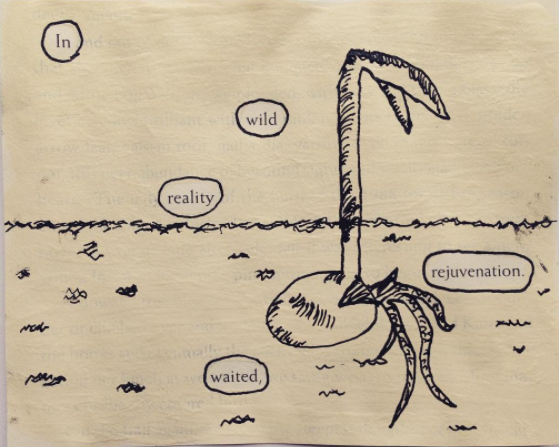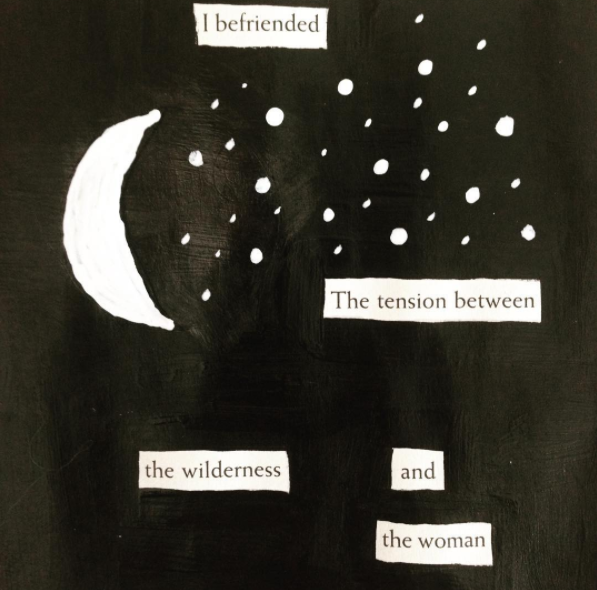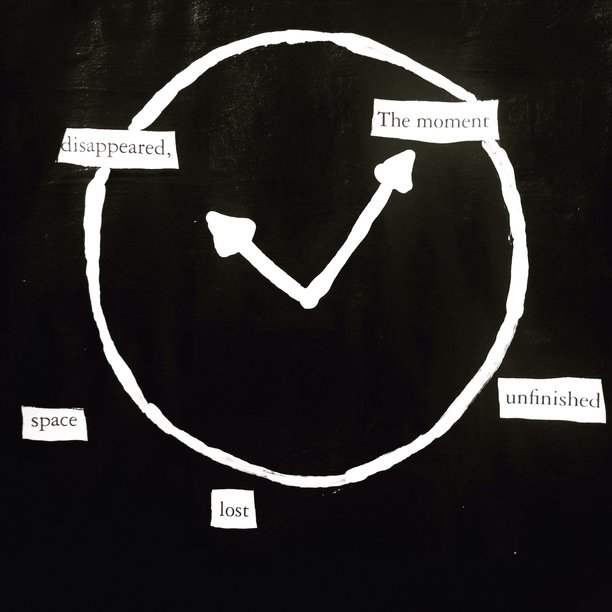If you follow me on Instagram, you may have noticed that I’ve recently dived headfirst into the blackout poetry rabbit hole. Why? Because making blackout poetry is a psyche-healing activity. There’s something about this process that is quiet and exciting and sacred and transformative. Like any other good creative undertaking does, making blackout poetry keeps leads you to discoveries about yourself.
Blackout poetry is one of those phenomenons that spiderwebs it’s way out through the world: I was inspired by the Instagram account @makeblackoutpoetry who was inspired by Austin Kleon and from there the inspiration goes back further and further and further, on and on and on. Suffice it to say people have been doing similar artwork for many years.
Since I’ve started sharing my blackout poems, I’ve had a few people message me and ask questions about the materials I use and how they can get started making their own blackout poetry. This makes me really excited because creating blackout poetry has really ‘clicked’ something within me, and I’d love to see others have that magical experience. Obviously I’m not an expert – I’ve only been doing this for a month or so – but I’ll share my process with you here. Listening to your curiosity will rarely lead you astray, so if this idea beckons to you, heed the call!
As you’re reading these steps, keep in mind that the only thing you really need to know about how to make blackout poetry is to do it however the hell you want to do it. Aside from seeing some examples online, I didn’t do any “research” when I started, I just started. Have fun and unleash your creativity!

How to make blackout poetry
1. Gather some old written materials (books, magazines, newspapers, whatever).
If you have some books languishing around that you’ve been meaning to donate, grab them. Those are the PERFECT candidates for blackout poetry. Any type of book (fiction, non-fiction, whatevs) will do but the thicker the pages, the better. I’ve tried to use some flimsy mass-market paperback books and that thin paper tends to fall apart.
If you don’t have any books like this already on hand, check your local thrift store and spend a few bucks on a couple of random books. You could also use free printed materials you were going to recycle anyway, such as newspapers, junk mail, old magazines…you get the idea.
2. Select a blackout medium.
I had some old acrylic paint gathering dust in a closet, so that’s what I’ve been using to redact text. There’s something very satisfying about smearing paint across an old book page, but you could also use a sharpie, a crayon, a pencil, a pen, or anything else you damn well please. I mainly use just black and white paint, and many blackout poets stick to a monochromatic aesthetic. But if color floats your boat, get colorful! I just started experimenting with watercolor in my blackout poetry and I’m excited to keep playing around with various mediums.
3. Get any other optional materials ready: varying sizes of paintbrushes, pens, scissors, paper towels, pencils, and a hair dryer (to dry paint).
Written material and a blackout medium are really the core materials you need, but I’ve found my blackout poetry supply kit quickly expanding. I now keep all of the stuff listed above on hand. You might also want some newspaper or an old towel to throw down on your working surface just to keep unwanted messes to a minimum. I now have a growing pile of supplies, I keep them on my bookshelf so that I can grab them whenever the poetry whim strikes.

4. Choose a page and find the words that stick out to you.
In a strange way, blackout poetry pushes some of the same buttons as reading tarot. Try to trust synchronicity, flip to a random page and see what words you’re drawn to. I try to avoid reading the entire page straight through, instead looking at the page in a more abstract way, as though it is a kind of word farm. Let your eyes focus on various words until one sparks something within you. Then using that word as a base, jump to other random words and see how they connect. Before you know it, you’ll have fished out your own unique phrase.
Sometimes I “find” my poem right away. Other times I spend a while staring at the page, trying to puzzle something together. And other times still, I can’t seem to farm out the right words and so I turn to a new page. If you find yourself getting too frustrated, wait and come back later. Creating blackout poetry should be fun and feel natural. If it’s stressing you out, it’s defeating the purpose!
Your poem can be as short or as long as you want. You might want to fuss about aligning your words so the poem is easier to read, or you might choose words from all over the page. Don’t overthink it, trust what feels right. When you’ve selected the words that will make up your poem, circle them with a pencil.

5. Blackout the words that aren’t part of your poem, then add optional artistic flourishes.
Now you get to be really brave and start transforming your page. Rip the page out of the book so it’s easier to handle. Get your paint (or marker, or whatever else) and cover up the excess words. I have had the unfortunate incident of accidentally painting over words that I DID want in my poem more than once, so now I start by highlighting the words I want to keep. Then I cover everything else. If you want, you can then use a hair dryer to dry your paint.
Congratulations, you’ve now made a blackout poem! It’s as simple as that. Of course, there are all sorts of flourishes you can do from here. I like to add some type of drawing or embellishment to my poem. This adds a new dimension of creativity to your work, and it can also be another way to express the theme of your piece. In the example pictured above, the words of my poem say “the moment disappeared, space lost; unfinished.” I decided to add a clock, tying into the theme of fleeting moments. If I’m using black paint to blackout, I add my flourishes with white paint. If I’m using white paint to blackout, I use a ballpoint pen to add flourishes. In this example, the finished product looks like this:

A few additional thoughts
When you’re done with a piece, you might want to write the date on the back. This way if you’re like me and go on a huge blackout poetry making expedition, you can look back on them almost like you would old journal entries. As with any other creative outlet, try not to fixate on how “good” your poems are or what other people will think about them. It can be really fun to share your pieces and I encourage you to do so if you want to (there’s a lovely blackout poetry community on Instagram). But it’s also totally cool to just have these be something you do purely to keep to yourself.
You’ll be amazed what you can glean about your current mental and spiritual state from your blackout poetry. Your unconscious mind is as influential in this process as your conscious mind. Above all else, blackout poetry is another adventurous way to explore the themes currently influencing your inner world. Try it!
And if you do share on Instagram, tag me (@carriemallon) so I can cheer you on.
Happy word farming,



 I'm a tarot reader and mentor.
I'm a tarot reader and mentor. 
This is really cool. I want to try this. It speaks to me first to my love of words and second to the just letting go and see what comes.
While I know there are no “rules” do you keep the pages in a folder or how are you keeping them? My first thought was to keep them in the book, sort of like an art journal. or perhaps the pages you rip out could be put into an art journal.
At any rate, thanks for sharing. I really like this.
That’s a good question. I honestly haven’t come up with a great way to store mine, they are just piling up on a shelf. I’ve been thinking about getting some plastic sleeves and a binder to store them. My fear is that they’ll disintegrate over time if I don’t find a way to preserve them! I also always photograph them right away so that I have a record of how they looked in case they do fade or anything over time.
That’s a good idea to photograph them. I’m going to experiment with keeping my pages in the book like an altered book project. Will see how it goes! Thanks again.
I love this idea!! I have a love for poetry and words, and a love for art and creating! So this really speaks to me. I am so happy i stumbled on this today, I can’t wait to try it!
Yay! I hope you have a wonderful time 🙂
Cheers, I value this.